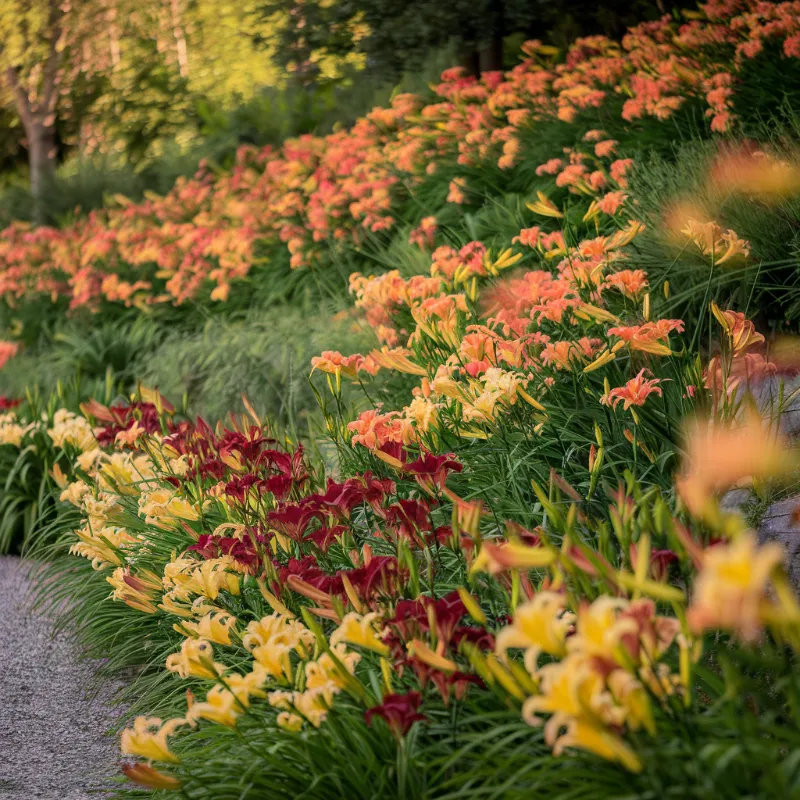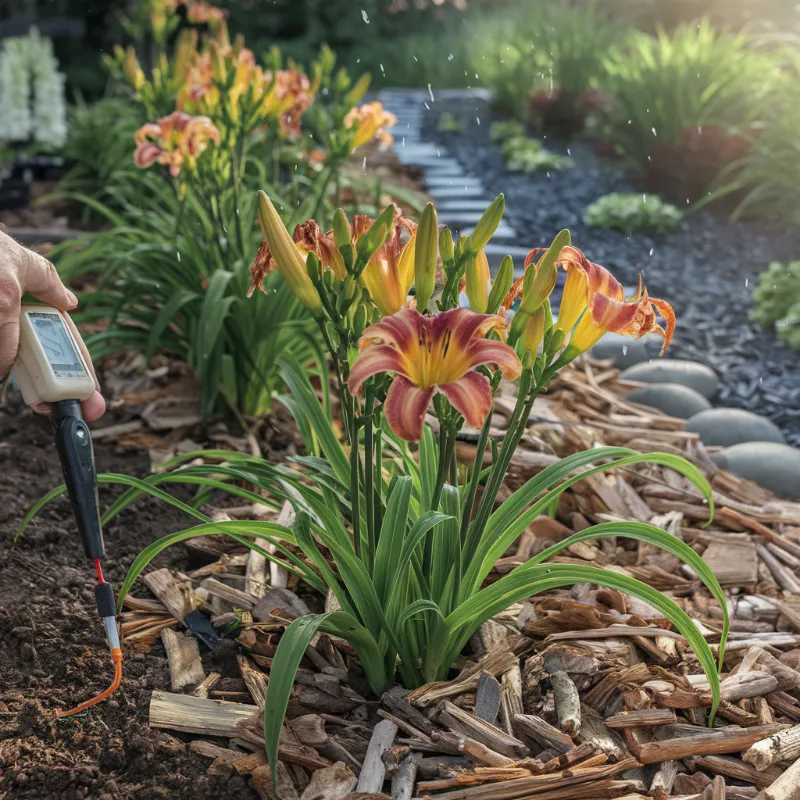Imagine Sarah’s backyard before. It was dull and lifeless. But then, daylilies changed everything. They turned her yard into a colorful, textured masterpiece. This shows how daylilies can make any outdoor space special.
Daylilies are perfect for those who want easy gardening. With over 15,000 types, they fit any garden design. They grow well in many climates, from Minnesota‘s cool to Florida’s warm. This makes them great for gardeners all over the U.S.
Daylilies are amazing because of their unique traits. Their stems can be short or tall, giving designers lots of options. They also bloom for weeks, changing the look of your garden constantly.
If you want a reliable, beautiful garden feature, daylilies are perfect. They grow well in many conditions and look stunning. This makes them a top pick for easy, yet beautiful landscaping.
Table of Contents
Understanding Daylily Basics and Their Landscaping Potentials
Daylilies are a versatile choice for garden design, with many options for gardeners. They add beauty and practical benefits to any landscape.
There are over 15,000 daylily varieties to choose from. Their adaptability makes them great for different landscapes.
What Makes Daylilies Perfect for Landscaping
Daylilies are great because they need little care. They thrive in tough conditions and different soils. They also need less water.
- Exceptional resilience in challenging growing conditions
- Ability to thrive in multiple soil types
- Adaptability to different light conditions
- Minimal water requirements
Different Types of Daylilies Available
Choosing reblooming daylilies keeps your garden interesting all season. They come in many types, including:
| Categorization | Description |
|---|---|
| Bloom Time | Early, mid-season, late-blooming varieties |
| Flower Color | Range from pale pastels to vibrant saturated hues |
| Scape Height | Varieties from compact 12-inch to tall 36-inch plants |
| Flower Form | Spider, trumpet, double, and ruffled shapes |
Growing Zones and Climate Adaptability
Knowing your growing zone is key to picking the right daylily. Choosing wisely ensures your garden thrives.
Choosing the right daylily variety transforms your landscape from ordinary to extraordinary.
Essential Benefits of Daylilies in Garden Design
Daylilies are top picks for perennial flower beds. They are easy to care for and look great in many settings. These plants solve many gardening problems and add beauty to different landscapes.
Daylilies are great for tough garden spots. They do well where other plants have trouble. They turn hard-to-grow areas into beautiful parts of the garden.
- Thrive in poor soil conditions
- Manage steep slopes effectively
- Control erosion in difficult terrain
- Provide consistent color with minimal intervention
People love daylilies because they are easy to care for. They need little attention but look amazing all season long.
| Characteristic | Performance Detail |
|---|---|
| Growing Zones | USDA Hardiness Zones 3-9 |
| Sun Requirements | Minimum 6 hours full sun |
| Water Needs | Approximately 1 inch per week |
| Soil pH Preference | 6.0 to 7.0 |
Daylilies are not just pretty; they also help the environment. They attract bees and butterflies. Their ability to naturalize in suitable areas helps create gardens that need little care and support local wildlife.
“Daylilies transform challenging landscapes into beautiful, resilient gardens with minimal gardener intervention.”
Daylilies come in many sizes and colors, giving gardeners lots of design options. They range from small to tall, making it easy to create interesting, layered gardens.
Landscape Uses for Daylily: From Borders to Problem Areas
Daylilies are great for tough spots in your garden. They are easy to care for and look good. This makes them perfect for both beauty and function in your yard.

Mass Planting Applications
Daylilies really stand out when planted in large groups. With over 15,000 types, you can make your garden look amazing. You can pick one type or mix them for a unique look.
- Create weed-resistant borders by planting daylilies 12-18 inches apart
- Select varieties with different bloom times for extended seasonal interest
- Choose cultivars ranging from 6 inches to 4 feet in height for diverse design options
Slope and Erosion Control
Daylilies are great for hard-to-manage areas. Their strong roots help keep the soil in place. This is perfect for stopping erosion on slopes.
| Landscape Challenge | Daylily Solution |
|---|---|
| Steep Slopes | Reduces soil erosion by 40% |
| Drainage Areas | Tolerates soggy soil conditions |
| Difficult Terrain | Provides ground cover and stability |
Border and Edging Solutions
Daylilies can turn simple garden edges into stunning features. They look great along fences, paths, or garden beds. They add beauty and serve a purpose.
*”Daylilies are nature’s solution to challenging landscape design problems.”*
Daylilies come in all sizes, from small for the front to tall for the back. They are easy to care for and can grow in many conditions. This makes them a top choice for anyone wanting beautiful, easy-to-maintain plants.
Creating Dynamic Color Schemes with Daylily Varieties
Daylily garden design offers a wide range of colors for those who love gardening. These plants come in many hues and textures. They help create beautiful outdoor spaces.
Choosing colors is key to making daylily arrangements stand out. Reblooming daylilies keep gardens looking lively all season long. They add depth and interest to any garden.
- Explore color wheel principles for harmonious combinations
- Select varieties with complementary and analogous color palettes
- Layer early, mid, and late-blooming varieties
| Color Category | Daylily Varieties | Visual Impact |
|---|---|---|
| Warm Tones | Orange, Red, Yellow | Energetic and Vibrant |
| Cool Tones | Purple, Lavender, Pink | Calming and Sophisticated |
| Neutral Tones | Cream, Pale Yellow | Subtle and Elegant |
When designing with daylilies, think about color transitions. Reblooming daylilies keep colors flowing, avoiding gaps in your garden’s look.
“A well-planned daylily garden is like a living canvas, continuously evolving and surprising the viewer.” – Garden Design Expert
By placing colors wisely and mixing them thoughtfully, you can turn any landscape into a masterpiece. Try out different daylily varieties to find unique and stunning garden designs.
Companion Planting Strategies with Daylilies
Companion planting is a smart way to make your garden look great and healthy. Daylilies are perfect for this because they can be paired with many plants. This makes your garden more beautiful and helps it grow well.
Optimal Plant Pairings
Choosing the right plants to go with daylilies is key. Look for plants that:
- Have different leaf textures
- Need the same amount of sunlight
- Bloom at different times
- Like the same amount of water
Strategic Companion Combinations
Here are some good pairings for daylilies:
- Hostas: They look great together
- Ornamental grasses: Add a cool texture
- Spirea and hydrangeas: Bring structure
- Dwarf evergreens: Keep things interesting all year
Spacing and Layout Considerations
It’s important to space plants right in your garden. Daylilies should be 18-24 inches apart. This lets them grow well and get enough air.
“The art of companion planting lies in creating a balanced, interconnected garden ecosystem.” – Garden Design Experts
Seasonal Interest Planning
Daylilies come in over 52,000 varieties. This means you can have a garden that changes with the seasons. Pick different bloom times to keep your garden interesting all year.
Design Tips for Container and Small Space Gardens
Daylily landscaping is perfect for gardeners with little space. Dwarf daylily varieties are great for container gardening. They turn patios, balconies, and small urban gardens into lively green spots.
- Select miniature daylily cultivars that grow 12-25 inches tall
- Choose containers that are 15-18 inches wide for roots to grow
- Use lightweight, peat-based potting mixes for good drainage
- Add time-release fertilizers for steady food
“Small spaces can become stunning gardens with the right daylily selection and care.”
Container gardening with daylilies needs careful planning. In cold zones, move potted daylilies to safe places or insulate them in winter. Pick reblooming varieties for more blooms all summer.
Urban gardeners and those with small outdoor areas will love daylilies. Mix different heights and colors for eye-catching container designs. These designs are easy to care for and look great.
Managing Moisture and Drainage in Daylily Beds

Daylily cultivation thrives with the right water management. These drought-tolerant plants need specific soil and moisture to grow well in easy-care landscapes.
Soil Preparation for Optimal Drainage
Starting with the right soil is key for daylilies. Gardeners should aim for soil that drains well and supports strong roots.
- Test soil pH between 5.2 and 6.7 for optimal nutrient absorption
- Incorporate organic matter to improve soil structure
- Ensure proper drainage to prevent water-logging
Strategic Watering Techniques
Daylilies are very drought-tolerant once they’re established. Knowing their water needs helps gardeners water wisely.
- Water deeply but infrequently to encourage robust root systems
- Reduce watering frequency during mature plant stages
- Monitor soil moisture levels carefully
Effective Mulching Methods
Mulching is vital for keeping moisture in and plants healthy. The right mulch can make daylily beds easy to care for.
- Use organic mulches like bark chips or pine straw
- Maintain 2-3 inch mulch layer around plants
- Avoid direct mulch contact with plant stems
*Proper water management transforms daylilies from simple plants to landscape masterpieces.*
With these moisture management tips, gardeners can make daylily beds that look great and are tough. They’ll handle different weather conditions well.
Frequently Asked Questions
What can daylilies be used for?
Daylilies are mostly used for landscaping because they’re tough, low-maintenance, and bloom beautifully. They work great as border plants, ground cover, or even as a pop of color in flower beds. Some people also use certain varieties for edible purposes, like adding the petals to salads, but always double-check the variety before eating.
How to use lilies in landscape?
Lilies (including daylilies) can be placed in garden beds, along walkways, or in mixed perennial gardens. They pair well with ornamental grasses, hostas, and shrubs. Taller varieties make great backdrops, while shorter ones are perfect for edging. They also work well in naturalized areas, adding a wild, cottage-garden feel.
Are daylilies good for soil erosion?
Yes! Daylilies have thick, fibrous roots that hold soil in place, making them great for erosion control. They work especially well on slopes or areas prone to runoff, helping to stabilize the ground while looking gorgeous.
Will daylilies choke out weeds?
Pretty much! Once they’re established, daylilies spread quickly and create dense foliage that crowds out weeds. They aren’t a perfect solution, but they definitely cut down on weed growth, making garden maintenance easier.
How do you use daylilies in landscape?
Daylilies are super versatile! You can plant them along fences, around mailboxes, or even in large drifts for a dramatic look. Mix them with other perennials for continuous blooms throughout the season, or use them in foundation plantings near your home.
What can I do with old daylilies?
If your daylilies are overgrown or not blooming as much, you can divide them and replant elsewhere. This keeps them healthy and helps fill in other areas of your yard. If you have extra, share them with friends or compost the old ones if they’re no longer thriving.

